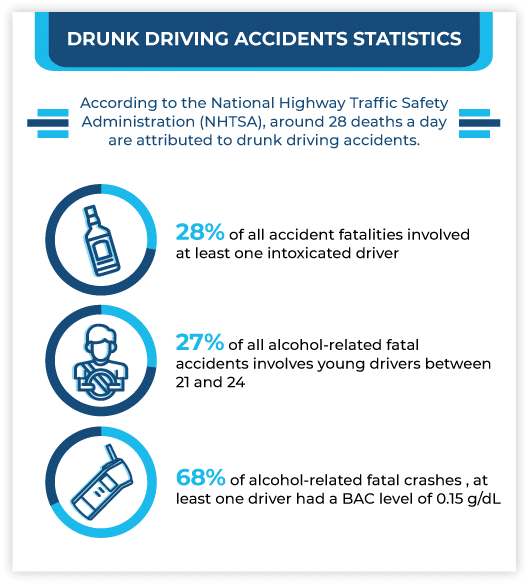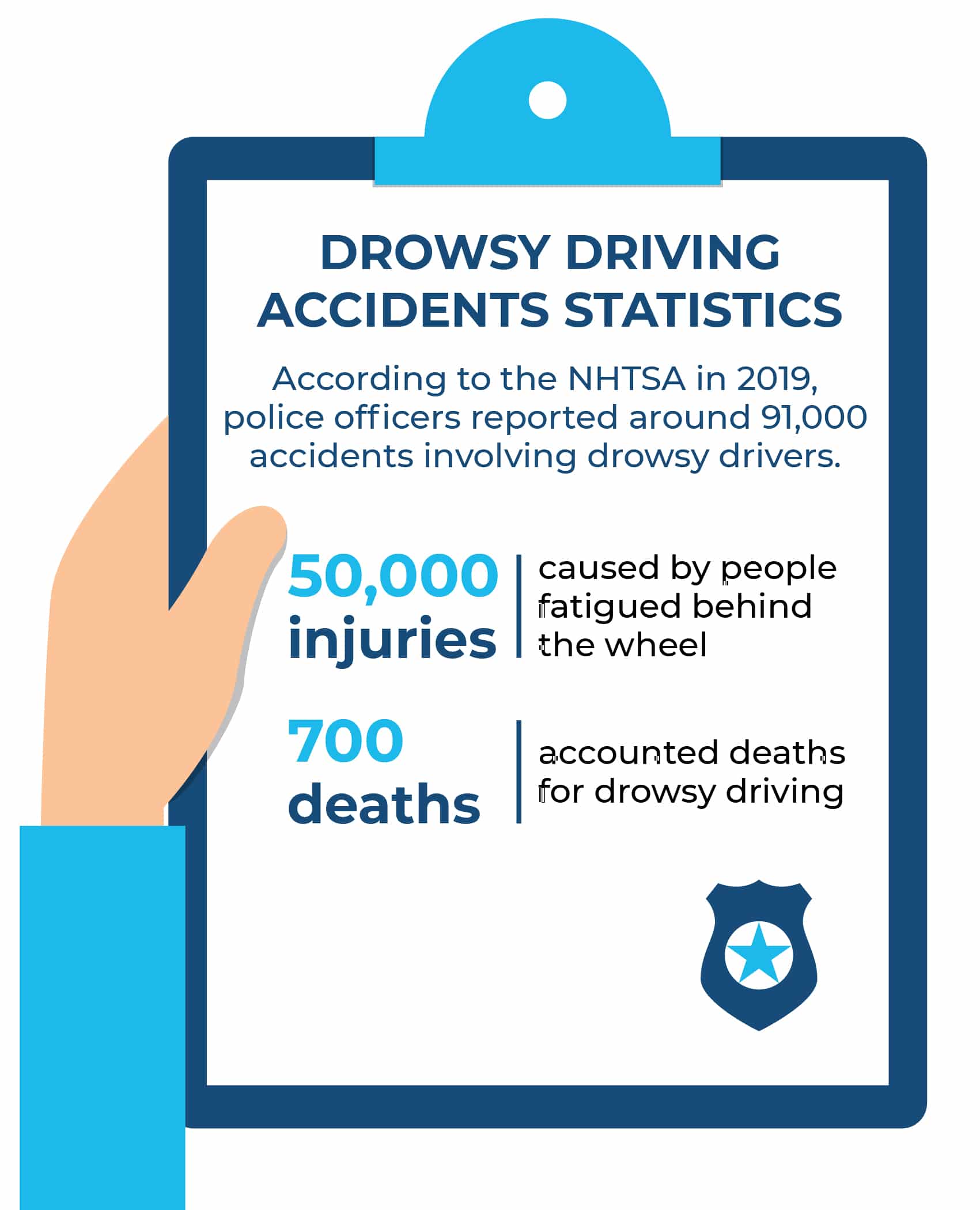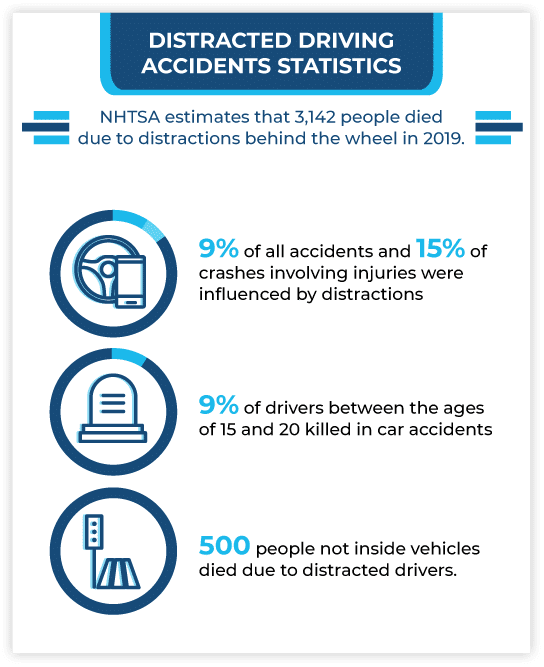Drunk Driving vs. Drowsy Driving vs. Distracted Driving
With millions of licensed drivers on the road in the U.S., it’s critically important that everyone drives safely. One-way commuting times have increased every year, reaching 27.6 minutes in 2019, partly because more people are driving extreme distances. As of 2019, 9.8% of workers indicated they drove more than an hour one way daily. With people on the road longer, there’s always the risk of some type of impaired driving, with the following three types being the most common:
Drunk Driving
Just one drink of alcohol can be enough to slow a driver’s reaction time and reduce muscle coordination, easily resulting in fatal crashes. Most states have established a legal limit for blood alcohol content (BAC) as low as 0.08. However, fatal accidents can happen with a BAC as low as 0.01. A driver’s ability to operate a vehicle diminishes starting with the first drink.
Drowsy Driving
Any condition that dulls reflexes and muscle coordination can be dangerous behind the wheel. Over the last few decades, the dangers of drowsy driving are becoming more apparent. Many experts have found that driving while fatigued can be just as risky as driving while intoxicated. Drowsy drivers include those suffering from actual sleep deprivation and others that are simply overly tired. Either condition can contribute to slower reaction times and motor vehicle accidents.
Distracted Driving
This third form of impaired vehicle operation is a common problem among teenagers. Texting, shuffling through music selections, eating, and conversing with passengers are all distracting driving behaviors that can lead to serious consequences. Crashes among young people especially are often the result of lapses in attention to the street.
What are the Effects of Impaired Driving?
While drunk, drowsy, and distracted driving are each part of the impaired driving problem, they have different causes and impacts. Knowing the differences is paramount to understanding associated risks and what dangers and outcomes to expect. Operating a vehicle with any of these impairments can result in serious car accidents and severe consequences mentally, emotionally, physically, financially.

Drunk Driving Effects
Whether in the form of beer, wine, or hard liquor, alcohol passes through the stomach and small intestine into the bloodstream. The BAC, or Blood Alcohol Concentration, refers to the amount of alcohol per deciliter of blood. Drinks with higher alcohol levels, such as hard liquors, can raise the BAC much faster than lower concentration drinks. Although alcohol is metabolized in the liver, it takes some time for this process to work. In general, the human body can reduce the amount of alcohol in the blood at a rate of 15 mg/100 ml/hour.
Alcohol is popular because it creates feelings of relaxation and euphoria. Higher levels of BAC have the drinker enter a state of intoxication. In this condition, there already exists a greater risk for car crashes. With more alcohol, speech can become slurred, and a person may have difficulty driving in a straight line. Unconsciousness will eventually take hold, which can have deadly consequences if the person is still behind the wheel.
Drowsy Driving Effects
Unlike drunk driving, drowsy driving can be harder to connect to a cause such as having a drink. A person who gets eight hours of sleep a night can still feel fatigued because of untreated sleep disorders, including insomnia, sleep apnea, or narcolepsy. Drowsiness can also happen during a long shift or as a result of not getting enough sleep. Commercial drivers can have problems with fatigue after a long drive.
Drowsiness and fatigue both affect driving in several ways. First, they can cause reduced alertness, causing drivers to have reduced awareness or miss important traffic signals. Secondly, they can slow reaction time, which can cause fatal car accidents. Third, both conditions can impact the driver’s ability to make attentive decisions based on the risk factors for sleep-related crashes.
According to studies, being awake for a full day is the same as having a BAC of 0.10%. This is beyond the legal limit in every state within the U.S. Going 18 hours without sleep is the same as a BAC of 0.05%. It’s important to note that the risk of a sleep-related crash may increase sharply with alcohol.
Distracted Driving Effects
Distracted driving can happen to sober and well-rested drivers. Conversations with passengers, texting and driving, and selecting music on the radio or other device have long contributed to driver inattention. However, in recent years, cell phone use and navigation systems have created an especially powerful lure.
Distracted driving can make vehicle operators more likely to crash in several ways. Removing hands from the steering wheel can make it more difficult to control the car in response to unforeseen circumstances. Taking one’s eyes off the road for even a few seconds at high speed is enough to cause an accident. A recent study by MIT found that humans can react to street hazards in under 600 milliseconds. However, that fast response can only happen when the eyes see the danger, and hands and feet are in their proper places to make the necessary corrections.
Driving at a speed limit of 55 miles per means the car moves the length of a football field every five seconds. Lives can be lost in the blink of an eye.
Statistics and Dangers of Each Type of Impaired Driving
Drowsy driving vs Drunk Driving Statistics
Drowsy driving is responsible for an estimated 6,000 fatal crashes in the US each year, while drunk driving is responsible for around 10,000 deaths per year. Both drowsy driving and drunk driving impair a driver’s ability to stay alert and react to changing road conditions, but the effects of drowsiness are often underestimated. In fact, being awake for 18 hours straight can impair a driver’s reaction time and judgment as much as having a blood alcohol concentration of 0.05%. Additionally, drowsy driving is more common than drunk driving, with surveys indicating that up to 60% of drivers have driven drowsy at some point. Overall, both drowsy driving and drunk driving pose a serious risk to public safety and drivers should prioritize getting enough sleep before getting behind the wheel or finding alternative means of transportation if they are impaired.
Drunk Driving Statistics
According to the National Highway Traffic Safety Administration (NHTSA), around 28 deaths a day are attributed to drunk driving accidents. In 2019, around 28% of all accident fatalities involved at least one intoxicated driver. In that same year, a driving fatality related to alcohol happened every 52 minutes. Young drivers between 21 and 24 are involved in 27% of all alcohol-related fatal accidents.
The rate of drunk drivers in fatal crashes is 3.3 higher during the night than in the daytime. In 68% of alcohol-related fatal crashes, at least one driver had a BAC level of 0.15 g/dL. That number is nearly twice the legal limit of 0.08.


Drowsy Driving Statistics
The statistics regarding tired drivers are not as clear as they are for drunk drivers because there’s no conclusive test for drowsy driving following an accident. However, the dangers of drowsy driving accidents are still important to traffic safety researchers because the consequences can be just as serious. According to the NHTSA in 2019, police officers reported around 91,000 accidents involving drowsy drivers.
In that same year, around 50,000 injuries were also caused by people fatigued behind the wheel. Additionally, drowsy driving accounted for around 700 deaths. Most drowsy driving accidents happen from midnight to 6:00 AM or in the afternoon. During these periods, people can get sleepier because of the natural circadian rhythm. Accidents often involve one vehicle occupant veering off the road at high speed without using brakes.
Distracted Driving Statistics
Much like the effects of drowsy driving, distracted driving can be hard to pin down after the accident. However, the NHTSA estimates that 3,142 people died due to distractions behind the wheel in 2019. Around 9% of all accidents and 15% of crashes involving injuries were influenced by distractions. That amounts to more than 420,000 people injured by distracted driving in 2019.
About 9% of drivers between the ages of 15 and 20 killed in car accidents faced a distraction contributing to the deadly event. That percentage is 3% more than the percentage of drivers of all ages killed in car accidents. Though, drivers aren’t the only ones at risk. In 2019, more than 500 people not inside vehicles (e.g., pedestrians and bicyclists) died due to distracted drivers.

How can impaired driving accidents be avoided?
Despite these dire statistics, the good news is each of these accident types are preventable. You can take some simple steps to help yourself, your friends, and your family members make safer driving choices. There are also larger social or policy steps that politicians and other experts and advocates can take to make the roads safer for everyone. Here are a few things people should know about preventing drunk, drowsy, and distracted driving events:
Drunk Driving
Planning is the best way to prevent drunk driving. If you’re going out to a bar or party where alcohol will likely be served, decide on transportation needs in advance of the trip. When traveling with a group, designate a person to drive sober.
Solo travelers may be tempted to drive because they’re only responsible for themselves. However, in this case, it’s best to take a ride-share service, such as an Uber, Lyft, or taxi. To ensure you follow-through with appropriate decision-making even after you’ve started drinking, try to schedule your drivers ahead of time to arrive at the conclusion of a party or other social event or outing. Better yet, use the rideshare service to and from your destination.
It’s also important to keep an eye out for intoxicated drivers on the roadways even if you’re sober. Don’t hesitate to contact the police to report drunk drivers on the road. Wear a seatbelt and remain alert while driving, especially at night and on weekends.
Cases involving persistent drunk drivers may require alcoholism screenings and ignition locks. These can be valuable tools for keeping repeat offenders off the road.
Drowsy Driving
To a certain extent, drowsy driving prevention also comes down to planning. For example, when taking long-distance trips, plan to stop for overnight stays long before fatigue sets in. Getting a good night’s sleep every night and treatment for any sleep disorders can also keep drivers from being too fatigued. Factors like working the evening shift may require extra effort toward getting quality rest every day.
Drivers should also learn to recognize the symptoms of fatigue while on the road, including:
- Drifting into other lanes or across rumble strips
- Trouble concentrating, getting lost, or forgetfulness
- Difficulty keeping eyes open or head up
- Yawning often
If these symptoms occur, take them seriously. Pull off the road to a safe, well-lit area and get some sleep or encourage others you’re riding with to do the same. Attempting to push through fatigue can endanger the lives of everyone on the road. Also, coffee and caffeine drinks are not always the solution. While coffee can help drivers feel alert, it’s not a substitute for sleep.
Distracted Driving
Like the previous categories, distracted driving prevention can also often come down to proper planning. Because we live in a world of constant distractions, it’s often wise to find ways to remain focused when driving. For example, when driving alone, navigation systems should include a clear and concise voice component. Also, set the route before driving, and use the audio for turn-by-turn directions during the trip. Pull over and stop to make corrections to the navigation system along the way if needed. To avoid the temptation of reading and sending new messages while driving, it’s also recommended that you set your phone to the “Do Not Disturb” mode before you get on the road.
Do not plan to conduct other activities while driving. Anything that’s not necessary for currently operating a vehicle should be handled before or after driving. Activities to be avoided while driving include eating, getting dressed, and adjusting the seats, audio system, or mirrors. Any children, pets, or loose equipment should be properly secured while the vehicle is stopped. In all cases, don’t hesitate to pull over to deal with any changes in circumstances.
Will autonomous driving solve these problems?
While self-driving cars show promise in their ability to help prevent intoxicated people from operating vehicles, or taking control when drowsy drivers fall asleep, such abilities are still in early development. However, current models can already warn drivers when they need to suddenly stop to avoid an object ahead, potentially helping distracted drivers.
Though the dangers of not fully autonomous driving vehicles is that partially equipped vehicles may lull drivers into a false sense of safety, thereby essentially leading to increased levels of driver inattention. With current autonomous driving technology, these vehicles still encounter obstacles they’re not prepared to navigate as deftly as people, meaning, for the foreseeable future, humans will need to remain alert, sober, and awake behind the wheel.


